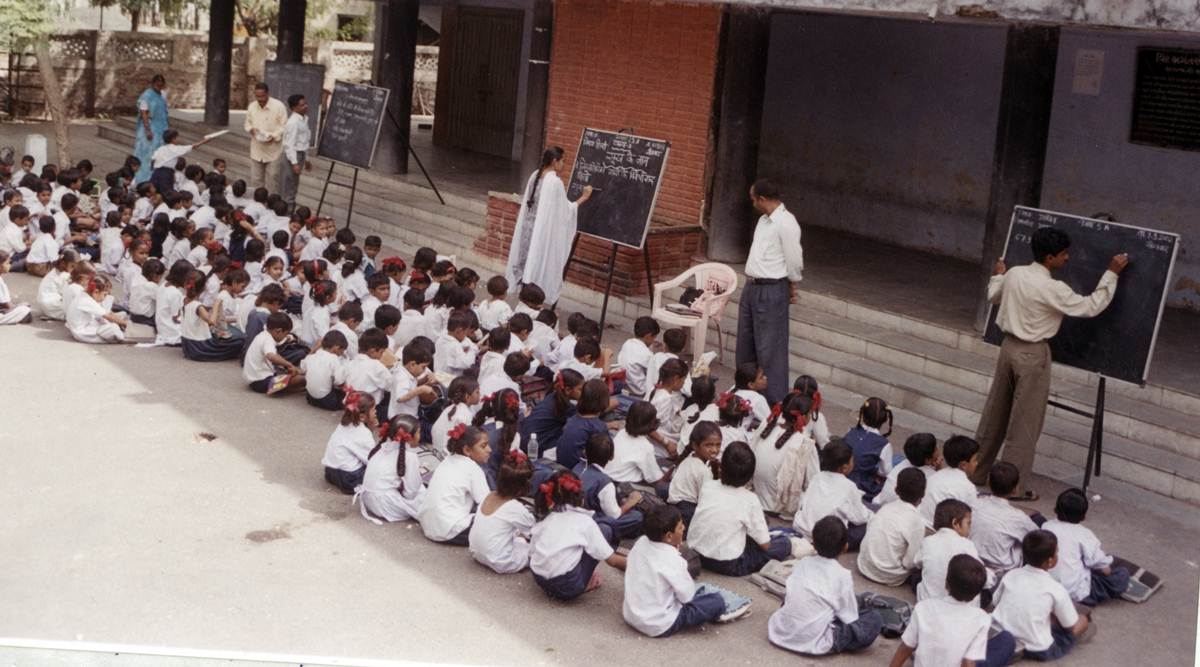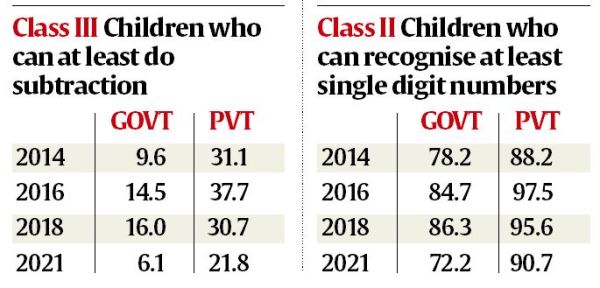 The proportion of children in class III who can read standard II-level text fluently has dipped from 29.8 per cent in 2018 to 12.3 per cent in 2021, the report says, indicating that learning outcomes of younger children, particularly those in government schools, have been severely hit.
The proportion of children in class III who can read standard II-level text fluently has dipped from 29.8 per cent in 2018 to 12.3 per cent in 2021, the report says, indicating that learning outcomes of younger children, particularly those in government schools, have been severely hit. The proportion of students in classes II, III, and VI in Chhattisgarh who are unable to recognise letters have doubled since 2018, coupled with a sharp drop in their basic mathematical skills, according to the latest Annual Status of Education Report (ASER), which captures Covid-related learning losses in one of the most backward states of the country.
According to the ASER survey, which covered 46,021 children aged 3-16 years across 33,432 households in 28 districts of Chhattisgarh in October-November 2021, the current foundational reading level among students in classes I-VII is “lower than at any time in the last decade”.
“The proportion of children at ‘beginner’ level (unable to recognise even letters) in Std II, Std III and Std VI is roughly double the corresponding level in 2018: it increased from 19.5% to 37.6% for children in Std II, from 10.4% to 22.5% in Std III, and from 2.5% to 4.8% in Std VI,” says the report.
The proportion of children in class III who can read standard II-level text fluently has dipped from 29.8 per cent in 2018 to 12.3 per cent in 2021, the report says, indicating that learning outcomes of younger children, particularly those in government schools, have been severely hit.


 Numbers show that until 2018, learning abilities were rising among children of all age groups. For example, 70.7 per cent children in class II of government schools could read letters in 2014,; it rose to 77.1 per cent in 2016; dipped marginally in 2018 to 76.3 per cent; and in 2021 went down to 57 per cent.
Numbers show that until 2018, learning abilities were rising among children of all age groups. For example, 70.7 per cent children in class II of government schools could read letters in 2014,; it rose to 77.1 per cent in 2016; dipped marginally in 2018 to 76.3 per cent; and in 2021 went down to 57 per cent.
In the case of mathematics, 14.2 per cent children in class III (government and private school combined) could do subtraction in 2014; the figure rose to 20 per cent in 2016; came down slightly in 2016 to 19.3 per cent; and in 2021 it stood at 9 per cent.
Among class V students, 18 per cent could do division in 2018; this rose to 23.1 per cent in 2016; 26.9 per cent in 2018; and fell to 13 per cent in 2021.
The survey also found that the proportion of children who are unable to recognise even single-digit numbers has increased across grades, and more so among students of classes I-V.
For example, the proportion of children at this level increased from 11.4 per cent to 24.3 per cent in class II, and from 1.7 per cent to 4.5 per cent in class V, the report states.
“Looked at over the previous decade, sharp drops in foundational arithmetic ability are visible among children in the primary grades (Std I-V), with children in government schools performing significantly worse than those in private schools,” the report says.
Like in Chhattisgarh, ASER had captured the status of learning outcomes in Karnataka in a report released in September 2021. This report, based on a sample assessment covering 20,000 children aged 5-15, had also found “steep drops” in foundational skills, especially in lower primary grades.
In terms of availability of resources such as smartphones and television, the survey found that private school students are better off compared to their government school counterparts.
As many as 88.5 per cent surveyed students of private schools had smartphones available at home, as against 79.1 per cent government school students.
Moreover, children in private schools are far more likely (8.1 per cent) to take paid private tuition classes than those in government schools (3.2 per cent), the survey found.
The report of the National Achievement Survey (NAS) carried out by the central government in November last year to assess learning outcomes of children across the country is expected to be released in March 2022.
- The Indian Express website has been rated GREEN for its credibility and trustworthiness by Newsguard, a global service that rates news sources for their journalistic standards.

